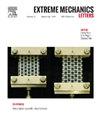The performance and evolution characteristics of the friction interface are crucial for the design optimization of material friction and wear, as well as the revelation of the mechanism of seismic sliding motion. To understand the friction behavior of rough surfaces, it is essential to understand the physical process of interaction among asperities. However, visualizing the contact of asperities is challenging because materials are typically opaque, and the dimensions of asperities are usually in the micron range. This study developed an in-situ scanning electron microscope friction device and a micro speckle fabrication method to measure the strain field of regular asperities from the side, and synchronously measure the macroscopic friction coefficient. In-situ friction experiments were conducted on brass and silicon materials. The results indicate that directly correlating the friction coefficient with the deformation and failure images of asperities can effectively explain the evolution process and differences in friction coefficient for the two materials, validating the performance of the device. Different failure modes of asperities were observed, including severe plastic deformation in brass asperities and fracture-producing large particles in silicon asperities. The critical transition of asperity failure modes in the experiments was analyzed based on a theoretical model. The phase diagram of asperity failure modes and friction coefficient evolution was plotted, providing potential explanation for the evolution of friction coefficient in friction experiments on randomly rough surfaces. The developed device in this study can be used for non-transparent materials and helps reveal the microscopic mechanisms behind experimental phenomena.


